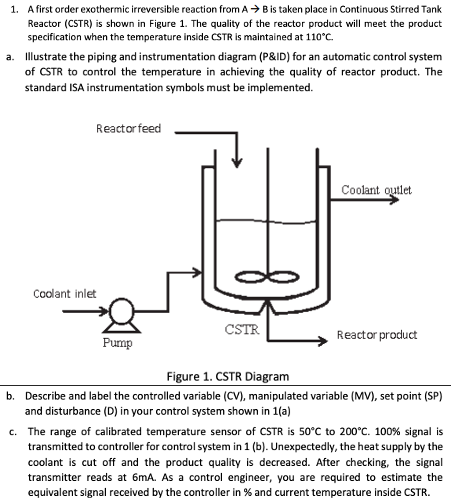1. A first order exothermic irreversible reaction from A→ Bis taken place in Continuous Stirred Tank Reactor (CSTR) is shown in Figure 1. The quality of the reactor product will meet the product specification when the temperature inside CSTR is maintained at 110°C. a. Illustrate the piping and instrumentation diagram (P&ID) for an automatic control system of CSTR to control the temperature in achieving the quality of reactor product. The standard ISA instrumentation symbols must be implemented. Reactor feed Coolant outlet Coolant inlet CSTR Reactor product Pump Figure 1. CSTR Diagram b. Describe and label the controlled variable (CV), manipulated variable (MV), set point (SP) and disturbance (D) in your control system shown in 1(a) c. The range of calibrated temperature sensor of CSTR is 50°C to 200°C. 100% signal is transmitted to controller for control system in 1 (b). Unexpectedly, the heat supply by the coolant is cut off and the product quality is decreased. After checking, the signal transmitter reads at 6mA. As a control engineer, you are required to estimate the equivalent signal received by the controller in % and current temperature inside CSTR.
1. A first order exothermic irreversible reaction from A→ Bis taken place in Continuous Stirred Tank Reactor (CSTR) is shown in Figure 1. The quality of the reactor product will meet the product specification when the temperature inside CSTR is maintained at 110°C. a. Illustrate the piping and instrumentation diagram (P&ID) for an automatic control system of CSTR to control the temperature in achieving the quality of reactor product. The standard ISA instrumentation symbols must be implemented. Reactor feed Coolant outlet Coolant inlet CSTR Reactor product Pump Figure 1. CSTR Diagram b. Describe and label the controlled variable (CV), manipulated variable (MV), set point (SP) and disturbance (D) in your control system shown in 1(a) c. The range of calibrated temperature sensor of CSTR is 50°C to 200°C. 100% signal is transmitted to controller for control system in 1 (b). Unexpectedly, the heat supply by the coolant is cut off and the product quality is decreased. After checking, the signal transmitter reads at 6mA. As a control engineer, you are required to estimate the equivalent signal received by the controller in % and current temperature inside CSTR.
Principles of Heat Transfer (Activate Learning with these NEW titles from Engineering!)
8th Edition
ISBN:9781305387102
Author:Kreith, Frank; Manglik, Raj M.
Publisher:Kreith, Frank; Manglik, Raj M.
Chapter2: Steady Heat Conduction
Section: Chapter Questions
Problem 2.22P: A cylindrical liquid oxygen (LOX) tank has a diameter of 1.22 m, a length of 6.1 m, and...
Related questions
Question

Transcribed Image Text:1. A first order exothermic irreversible reaction from A > B is taken place in Continuous Stirred Tank
Reactor (CSTR) is shown in Figure 1. The quality of the reactor product will meet the product
specification when the temperature inside CSTR is maintained at 110°C.
a. Illustrate the piping and instrumentation diagram (P&ID) for an automatic control system
of CSTR to control the temperature in achieving the quality of reactor product. The
standard ISA instrumentation symbols must be implemented.
Reactor feed
Coolant outlet
Colant inlet
CSTR
Reactor product
Pump
Figure 1. CSTR Diagram
b. Describe and label the controlled variable (CV), manipulated variable (MV), set point (SP)
and disturbance (D) in your control system shown in 1(a)
c. The range of calibrated temperature sensor of CSTR is 50°C to 200°C. 100% signal is
transmitted to controller for control system in 1 (b). Unexpectedly, the heat supply by the
coolant is cut off and the product quality is decreased. After checking, the signal
transmitter reads at 6mA. As a control engineer, you are required to estimate the
equivalent signal received by the controller in % and current temperature inside CSTR.
Expert Solution
This question has been solved!
Explore an expertly crafted, step-by-step solution for a thorough understanding of key concepts.
This is a popular solution!
Trending now
This is a popular solution!
Step by step
Solved in 3 steps with 2 images

Knowledge Booster
Learn more about
Need a deep-dive on the concept behind this application? Look no further. Learn more about this topic, mechanical-engineering and related others by exploring similar questions and additional content below.Recommended textbooks for you

Principles of Heat Transfer (Activate Learning wi…
Mechanical Engineering
ISBN:
9781305387102
Author:
Kreith, Frank; Manglik, Raj M.
Publisher:
Cengage Learning

Principles of Heat Transfer (Activate Learning wi…
Mechanical Engineering
ISBN:
9781305387102
Author:
Kreith, Frank; Manglik, Raj M.
Publisher:
Cengage Learning